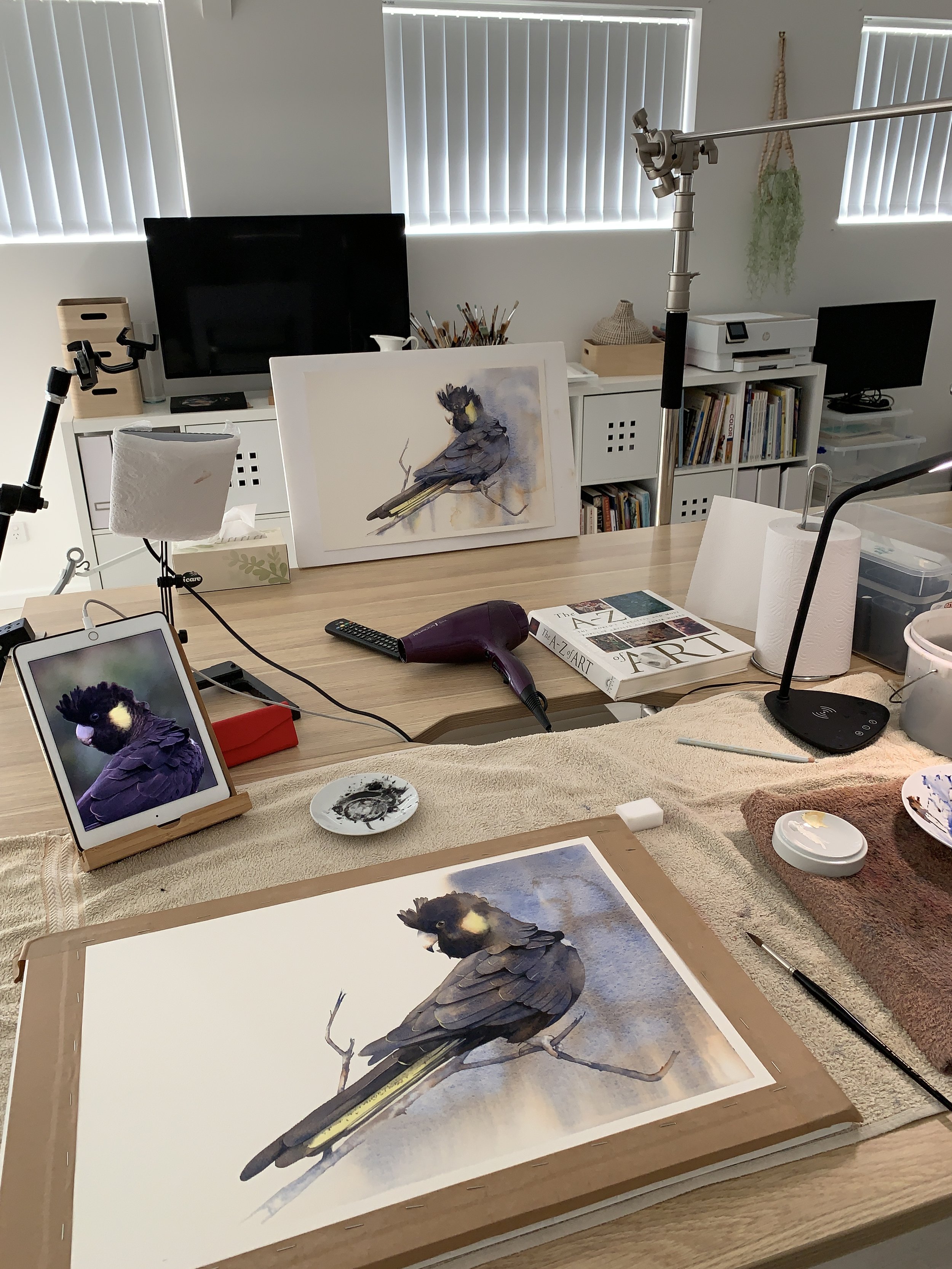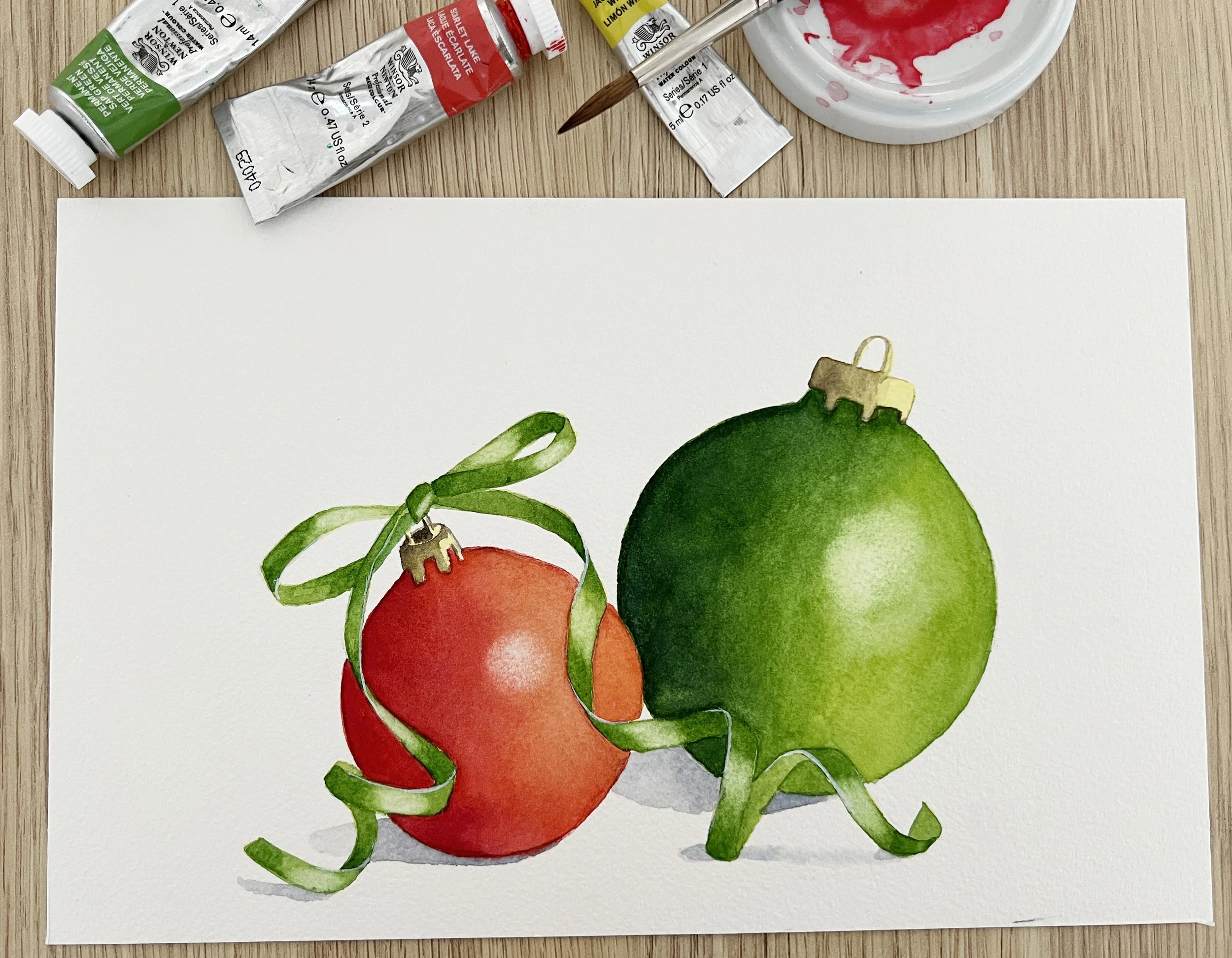How to Improve Your Art Skills
Studies, Persistence, and Repetition Can Transform Your Own Work
Practicing art - trying to improve my non-existent landscape painting skills.
As an artist, the path to mastering your craft is not always straight. It often involves detours, setbacks, and, most importantly, learning from your mistakes.
Today, I want to share with you a personal habit that has profoundly impacted my art practice -embarking on focused studies and embracing both persistence and repetition as integral parts of the creative process. This approach has not only improved my painting skills but also deepened my understanding of various artistic elements like composition, colour choices, and problem-solving.
The Power of Doing Studies
A few years ago, I began incorporating studies into my regular creative practice, especially when I was about to undertake a challenging subject. For example, while working on a series featuring the majestic yellow-tailed black cockatoo, a visitor in our garden, I found myself needing to iterate several times to capture its essence correctly.
I love painting birds, and it's a lot of fun for me, but it wasn't working at the beginning. Even though I worked off reference photos, I needed a better understanding of what I wanted to achieve. The first painting did not turn out as planned, prompting me to start over, not once but multiple times. I had to develop new ideas and spend time practicing creating a beautiful artwork.
I was able to avoid the mistakes I made with the studies on the main painting.
I had to practice a few times until I finally painted a Cockatoo that I was pleased with.
These initial attempts were not failures but rather steps in the learning process. Each study brought new insights, whether it was about the placement of elements like leaves in the composition or technical aspects like the use of masking fluid on feather tips. By not treating these studies as mere warm-up exercises but as serious attempts at the final artwork, I changed my entire approach. If a study turned out exceptionally well, it had the potential to become a sellable piece of art in its own right.
Learning Through Repetition
In my work with the black cockatoo, I discovered the importance of repetition. After abandoning the first painting due to its disjointed appearance, I tried different techniques in the subsequent versions. For instance, I moved away from using masking fluid, which I found gave an unnatural appearance to the highlights, to experimenting with white gouache, which yielded better results. Each repetition brought me closer to what I envisioned, helping refine my technique and teaching me what worked and what didn’t.
I used gouache to apply the yellow markings on the feathers because masking fluid didn't work very well for me on one of the studies.
Persistence Pays Off
Persistence was crucial in this journey. Each study, with its own set of challenges and learnings, informed the next. Despite being satisfied with the general direction of a painting, sometimes things as minute as the shade of a colour or the fluidity of a brushstroke could throw off the entire piece. This was evident when I experimented with the background washes and how they interacted with the foreground. Adjusting the wetness of the paper, the angle of the board, and even the timing of each stroke were all critical elements that I tweaked along the way.
Practice helped me to perfect the background wash.
After several attempts and adjustments, I finally created a piece that not only met but exceeded my expectations. This wouldn't have been possible without the persistence to push through after each setback. I learned to let go of frustration and embrace each 'failed' painting as a stepping stone toward my goal.
I am not the only one, who greatly benefits from persistence and repetition. Many other artists also developed new art skills and improved greatly by practicing art over and over again. I am inspired by the likes of Claude Monet and Winslow Homer, who also leveraged the power of repetition.
Harnessing the Power of Repetition: How Claude Monet Mastered Light and Colour
Monet's Blue Waterlilies - oil on canvas.
Claude Monet’s methodical return to the same subjects under varying conditions of light and season -seen in his celebrated series of the Water Lilies, Haystacks, and Rouen Cathedral - illuminates the power of repetition.
Each series, whether capturing the ephemeral reflections of light on water or the transient effects of sunlight on haystacks, allowed Monet to deeply explore colour dynamics and atmospheric changes. His Rouen Cathedral series, in particular, showcases how different times of day influenced the colour and texture of the same façade, enhancing his understanding of light. Through these repeated studies, Monet not only honed his artistic skills, but also profoundly impacted the development of Impressionism by emphasising light and colour over realism.
His approach demonstrates that repetition in art can lead to a richer, more nuanced understanding of a subject, ultimately guiding artists toward greater creative depths.
Winslow Homer and the Sea
Winslow Homer, an American artist best known for his marine landscapes, often revisited the same scenes and subjects to delve deeper into the interplay of light, atmosphere, and the raw power of nature, particularly the sea.
Winslow Homer: The Gulf Stream - oil on canvas
Throughout his career, Homer was drawn to the dynamic and often tempestuous relationship between humans and the sea. After moving to Prouts Neck, Maine, in the later part of his life, he began to focus intensely on the Atlantic Ocean, painting it under various weather conditions and at different times of day. This repetition allowed him to capture the myriad moods of the sea and the rugged beauty of the coast, experimenting with colour and technique to reflect changes in light and atmosphere.
Homer is also celebrated for his mastery of watercolour, a medium he took up later in his career but one in which he quickly excelled. He painted many scenes of the Bahamas, Florida, and the Caribbean, where he experimented with capturing the clear light and vibrant colours of the tropics. His repeated focus on scenes of fishing and coastal life not only solidified his art skills in depicting water, but also in using the fluidity of watercolours to render scenes filled with movement and life.
Winslow Homer: Breezing Up - 1876
Winslow Homer’s repeated return to certain motifs and environments, especially the sea, was not a sign of limitation but a testament to his deepening understanding and evolving approach to painting. By revisiting the same subjects, he could explore new ideas and techniques, making each repetition a unique study and an opportunity to refine his command of watercolours. His work exemplifies how repetition can be a powerful tool for watercolourists and all artists seeking to learn new skills and deepen their engagement with their subjects and their medium.
The Magic of Artistic Growth
The journey of creating art is as much about the process as it is about the final outcome. My experience with painting the yellow-tailed black cockatoo taught me that the magic happens not when things go perfectly the first time, but when you are willing to persist, repeat, and learn from each attempt. For emerging artists, remember that frustration and doubts are part of the creative process. Embrace them, and let them guide you towards improvement.
I encourage all aspiring painters to copy the great artists' habit of a daily routine and incorporate studies into their practice, to persist through challenges, and to repeat techniques until they yield the desired outcome. These elements are crucial for growth and developing confidence, and can significantly enhance your skills and understanding of art. Keep going, keep learning, move out of your comfort zone and let each brushstroke take you closer to the artist you aspire to be.
Now it's your turn to create art
If you'd like to try painting this yourself, I have an online tutorial where I walk you through it step by step. If you’d like to join my own community, join me on Patreon, where you’ll have access to a thriving community of thousands of like-minded artists. You’ll also receive access to my patron only Discord server. You can share your results on Patreon or Discord - I would love to see your progress!
Prints of this painting are available on my website. Every print sold contributes to tree planting efforts across Australia, combining art with activism.
Prints of this painting are available on my website.
I have online art courses on Patreon where you can pay a subscription to have access to them. I recently opened the Louise De Masi Art School where you can purchase an individual art class and tutorials and have lifetime access to it. Whether you're starting your watercolour journey or looking to refine your techniques, these classes are designed to inspire and guide you step by step.
I'm very excited to introduce my new line of merchandise. The collection includes t-shirts, hoodies, mugs, and a cute embroidered apron.
With love and a splash of watercolour,
Louise
If you are interested in learning to paint in watercolour, I have over 170 online, voiced over watercolour tutorials for all skill levels.














